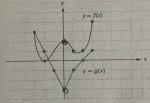For some reason I've had some difficulty understanding combining functions graphically. If someone could help me I would greatly appreciate it.
 If anyone has a problem seeing this graph let me know and I'll try something else.
If anyone has a problem seeing this graph let me know and I'll try something else.
The questions are :
a. compute f(0)-g(0)=
b.For what values of x does g(x)=f(1)
c.For the interval [0,3] is the quantity g(x)-f(x) positive or negative? Briefly explain.
d. Compute f(x)-f(2) / x-2
Thank you in advance, I'm not necessarily looking for the answers anything would help.
 If anyone has a problem seeing this graph let me know and I'll try something else.
If anyone has a problem seeing this graph let me know and I'll try something else.The questions are :
a. compute f(0)-g(0)=
b.For what values of x does g(x)=f(1)
c.For the interval [0,3] is the quantity g(x)-f(x) positive or negative? Briefly explain.
d. Compute f(x)-f(2) / x-2
Thank you in advance, I'm not necessarily looking for the answers anything would help.
